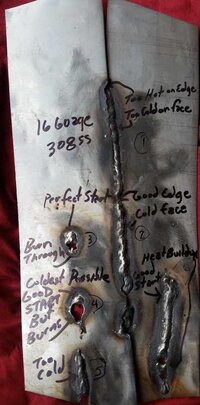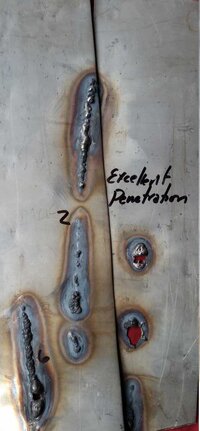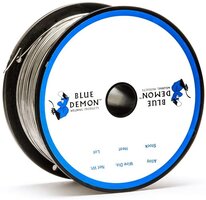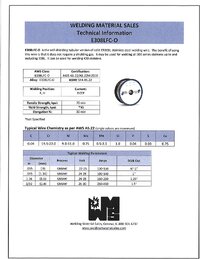Can anyone give me points to flux weld my exhaust? I know it would be better to mig or tig but I only have access to a flux welder and if I pay someone to do it the boss isn't gonna be happy with how much has already been spent on it recently. It also unfortunately only takes .035 gauge wire
You are using an out of date browser. It may not display this or other websites correctly.
You should upgrade or use an alternative browser.
You should upgrade or use an alternative browser.
Flux welding exhaust
- Thread starter MBS1994
- Start date
TequilaWarrior
Member
I haven't welded in decades.... and exhaust welding is a different animal... BUT....
any tips are going to depend on several factors:
What are you welding exactly? Welding up cracks is not like welding up joints.
What is the material (exactly) that you're welding? Stock exhaust is aluminized cold rolled steel - welding this will be "interesting" and will likely compromise the aluminum coating which will lead to fairly rapid rusting. Aftermarket stainless exhaust will weld differently as stainless steel is not like welding other materials. I'm not sure if flux welding SS is a good idea at all and different grades of stainless can have wildly different welding parameters and properties.
Are you welding over/through rust? One word: don't. Welding works best when both pieces are of the same material and in good / clean condition (i.e. no rust whatsoever). Can you weld over/through rust? Sure... will it be easy? No. Would it last? Again, no.
If you're welding up cracks (and perhaps there is rust in/around the cracks): CLEAN the area very well with a steel brush and or file/sandpaper. The welded area should be bright (shiny). Also, spray it off with a solvent of some kind that evaporates well like electrical contact cleaner or brake cleaner. BE 100% CERTAIN the cleaner is 100% gone before you weld. Some of these chemicals create phosgene gas when heated... this can kill you (totally not kidding).
Be aware that welded "repairs" on an exhaust are not generally a long term solution. I've had pieces "spliced" in to my exhaust and they've lasted multiple years however I don't anticipate they'll last the remainder of the life of the vehicle. Every one of these splices was welded in by cutting away rusted pipe until good solid relatively rust-free pipe was reached, then an air grinder was used to clean the joints before welding. The gentleman that did the welding does race-car chassis and rollbars and the like - but generally doesn't do exhaust work. I convinced him to do so as a personal favor. He did so under protest, then made me watch... lol. Afterwards, he made me swear never to ask him to do that again.
any tips are going to depend on several factors:
What are you welding exactly? Welding up cracks is not like welding up joints.
What is the material (exactly) that you're welding? Stock exhaust is aluminized cold rolled steel - welding this will be "interesting" and will likely compromise the aluminum coating which will lead to fairly rapid rusting. Aftermarket stainless exhaust will weld differently as stainless steel is not like welding other materials. I'm not sure if flux welding SS is a good idea at all and different grades of stainless can have wildly different welding parameters and properties.
Are you welding over/through rust? One word: don't. Welding works best when both pieces are of the same material and in good / clean condition (i.e. no rust whatsoever). Can you weld over/through rust? Sure... will it be easy? No. Would it last? Again, no.
If you're welding up cracks (and perhaps there is rust in/around the cracks): CLEAN the area very well with a steel brush and or file/sandpaper. The welded area should be bright (shiny). Also, spray it off with a solvent of some kind that evaporates well like electrical contact cleaner or brake cleaner. BE 100% CERTAIN the cleaner is 100% gone before you weld. Some of these chemicals create phosgene gas when heated... this can kill you (totally not kidding).
Be aware that welded "repairs" on an exhaust are not generally a long term solution. I've had pieces "spliced" in to my exhaust and they've lasted multiple years however I don't anticipate they'll last the remainder of the life of the vehicle. Every one of these splices was welded in by cutting away rusted pipe until good solid relatively rust-free pipe was reached, then an air grinder was used to clean the joints before welding. The gentleman that did the welding does race-car chassis and rollbars and the like - but generally doesn't do exhaust work. I convinced him to do so as a personal favor. He did so under protest, then made me watch... lol. Afterwards, he made me swear never to ask him to do that again.
I oxy/acetylene welded up an exhaust system made out of several leftover parts many years ago. Drove it for years after that and it held together. But I'm not in the rust belt so YMMV.
When I finally cut the can on my TB I'll probably weld on a straight pipe.
I find gas welding is more tolerant of minor rust.
When I finally cut the can on my TB I'll probably weld on a straight pipe.
I find gas welding is more tolerant of minor rust.
Beacon
Member
it may help if you could tell us what exact part that you are trying to weld... for example someone may want to patch and weld a hole in the muffler, while the next guy wants to weld the exhaust manifold, and yet the third guy want to weld a rusted out cracked piece of pipe
or even a joint that is typically held by a clamp
or even a joint that is typically held by a clamp
If you are using some Exhaust Piping that approximates the thickness of the Steel Pipe being demonstrated in this video... 0.030" Gauge Wire would draw less Heat and so your efforts would be less likely to so easily burn holes through almost as soon as you start to make your Tack Welds.
Nonetheless, these Two VOP (Video Original Posters) are just Average Guys who are self-taught and have admitted to failing their way into gradually becoming a Better Welders.
Practicing with ALL of the necessary Materials well in advance of attempting it on the 'Real Deal Steel'... would greatly help your Technique and thus, improve your Confidence as you progress. Setting up the Welder properly, Using the Right Wire (I know ...your Stuck with using the 0.035" Wire) and having the Right Wire Feed Speed while developing Consistent, Positional Weld Nozzle Control is only 10% of the Battle.
The remaining 90% is simply wasting your way through enough Practice Cut Piping Sections and Welding Wire to finally create Welds that if not Beautiful... at the very least ...will be Practical and Leak Proof. I HATED having to learn How to Weld in High School... until I got good at it .... and You will feel the very same way... if you just "Stick" With It. :>) Watch for some fairly good tips from this Dude:
PS: The VOP (Video Original Poster) Demonstrates his Practice Welding Techniques WITHOUT Wearing Leather Gloves... risking UV Light Skin 2nd Degree Burn Damage and/or Skin Cancer Lesions on his Fingers, Hands and Arms later in life. THAT is a Big No Should Do...
Protect Yourself With ... A Shade 10-12 Hood Glass Full Face Shield to avoid PERMANENT BLINDNESS and always Wear a Long Sleeve Shirt and use a Pair of Leather Gloves. Watch THIS Dude for another Example and some more Basic Flux Welding Tips:
Nonetheless, these Two VOP (Video Original Posters) are just Average Guys who are self-taught and have admitted to failing their way into gradually becoming a Better Welders.
Practicing with ALL of the necessary Materials well in advance of attempting it on the 'Real Deal Steel'... would greatly help your Technique and thus, improve your Confidence as you progress. Setting up the Welder properly, Using the Right Wire (I know ...your Stuck with using the 0.035" Wire) and having the Right Wire Feed Speed while developing Consistent, Positional Weld Nozzle Control is only 10% of the Battle.
The remaining 90% is simply wasting your way through enough Practice Cut Piping Sections and Welding Wire to finally create Welds that if not Beautiful... at the very least ...will be Practical and Leak Proof. I HATED having to learn How to Weld in High School... until I got good at it .... and You will feel the very same way... if you just "Stick" With It. :>) Watch for some fairly good tips from this Dude:
PS: The VOP (Video Original Poster) Demonstrates his Practice Welding Techniques WITHOUT Wearing Leather Gloves... risking UV Light Skin 2nd Degree Burn Damage and/or Skin Cancer Lesions on his Fingers, Hands and Arms later in life. THAT is a Big No Should Do...
Protect Yourself With ... A Shade 10-12 Hood Glass Full Face Shield to avoid PERMANENT BLINDNESS and always Wear a Long Sleeve Shirt and use a Pair of Leather Gloves. Watch THIS Dude for another Example and some more Basic Flux Welding Tips:
Last edited:
I appreciate all the comments. It's a 3 inch 304 SS y pipe with cats I already welded in, kinda. My welds were real bad when I did it months ago because I didn't know what I was doing and now I think its caused other problems. I actually watched that first video plus his other one and about 30 other welding videos. I feel good that I can do a better job now. What I have been trying to find through searches is settings for the machine using the .035 but only see people saying use smaller wire or that they did it but no details. I also need to weld some broken manifold bolts out of the head but the wire for that doesnt seem to matter as much.
Beacon
Member
Are you using stainless wire? and IIRC helium or a helium/blend is the correct gas. Some of the small "home owner" welders are capable of using gas. I recommend trying that, even at extra cost of buying the gas for a one time job
edit
have tried to go to your local welding supply store and see what options and recommendations they may have?
edit
have tried to go to your local welding supply store and see what options and recommendations they may have?
Yes,.. Turn the Amperage Setting UP in this situation to get More Heat concentrated into the Broken Bolt Shank with short, controlled Burts. Then wait patiently for the Welded On Nut to Cool Down ...FIRST... Before attempting to Work the Bolt...Slightly Tighter then Slightly Loose... Back and Forth just a little at a time... with no rushing once you feel it beginning to move... it should unwind quite nicely.
Last edited:
The welder at my work is just a flux core welder. It's a lincoln pro hd or something along those lines. I found a harbor freight welder that can run the .030 wire for 100 and my wife is on board but I'd rather save cost for now to be able to do my shift kit. And no I didn't think of a welding supply store but that's a good pointAre you using stainless wire? and IIRC helium or a helium/blend is the correct gas. Some of the small "home owner" welders are capable of using gas. I recommend trying that, even at extra cost of buying the gas for a one time job
edit
have tried to go to your local welding supply store and see what options and recommendations they may have?
Good to know thank you.Yes,.. Turn up the Setting to get More Heat concentrated into the Bolt...and wait patiently for the Nut welded on to Cool Down ...FIRST... Before attempting to work the Bolt...Slightly Tight then Slightly Loose.,. Back and forth just a little at a time... with no rushing once you feel it beginning to move.
I can't tell if you are using Stainless Steel Flux Core (Only available in .035") but if not... while welding with S/S Wire and a Gas Mix...it is possible to weld INTO Mild and Carbon Steels... but the REVERSE approach of using Carbon Steel Flux Core Wire will WEAKEN the S/S substrate and invite fractures. THIS Flux Wire is specifically made for Welding Stainless Steel GAS FREE and will produce astonishing results as long as you don't try doing lengthy, continuous welds or attempt to use it on Thin 16 Gauge S/S ...as the 'Burn-Thrus' on your work pieces will frustrate the Hell out of you.
(NOT My Welds....)


A One Pound Roll of this Stuff from Blue Demon goes for around $33.00 on Amazon. Pay Very Close Attention to the issues of Changing Polarity, The Toxic Fumes Indoors, The "Bacon Spatter, BBs & Buckshot" Mess that will be left behind if you don't use some "Spatter Spray" ahead of mock-up time. The Wire Gauge OD Limitations and the other problem of having Pre-Sets on Low Buck Machines with limited Wire Feed-Speed and Voltage settings come right along with using 120 VAC Machines in 15 Amp Circuits and Limited Duty Cycles:


THIS Stainless Steel Flux-Core Wire is great when used with a lot of practice to find the right combinations of Wire Feed, the Correct Torch Angle (5-10 degrees when pulling the Wire) and your Drag Speed and Heat Settings. If you can get the right 120 VAC machine that can handle around 140 Amps, Welding Stainless Steel on anything between 1/8" to 1/4" in thickness can be made to work ...and maybe even made to LOOK pretty good, too... Watch what this Expert manages to do with it on a 240 VAC Machine... WITH NO GAS:
To Whom It May Concern:
I CANNOT STRESS THIS ENOUGH... INHALING HALIDES OR HALOGENS LIKE HEXAVALENT CHROMIUM VAPORS WHEN WELDING STAINLESS STEEL WITH ANY TYPE OF WELDER AND RODS OR ELECTRODES IS EXTREMELY DANGEROUS.

DO NOT FLUX-WELD INDOORS WITHOUT A CONSTANTLY WORKING EVACUATION HOOD OR WITHOUT USING A STRONG FAN OUT OF DOORS IN ORDER TO BLOW THESE FUMES AWAY FROM YOUR FACE AND CLEAR OF YOUR BREATHING SPACE.
THE INCREASED RISK OF A FIRE HAZARD IS ALSO MOST IMMEDIATE AND UNAVOIDABLE IF YOU ARE ATTEMPTING TO FLUX-WELD INDOORS:
An Anecdotal Reference that cover these points in scant detail:
 welditmyself.com
welditmyself.com
(NOT My Welds....)


A One Pound Roll of this Stuff from Blue Demon goes for around $33.00 on Amazon. Pay Very Close Attention to the issues of Changing Polarity, The Toxic Fumes Indoors, The "Bacon Spatter, BBs & Buckshot" Mess that will be left behind if you don't use some "Spatter Spray" ahead of mock-up time. The Wire Gauge OD Limitations and the other problem of having Pre-Sets on Low Buck Machines with limited Wire Feed-Speed and Voltage settings come right along with using 120 VAC Machines in 15 Amp Circuits and Limited Duty Cycles:


THIS Stainless Steel Flux-Core Wire is great when used with a lot of practice to find the right combinations of Wire Feed, the Correct Torch Angle (5-10 degrees when pulling the Wire) and your Drag Speed and Heat Settings. If you can get the right 120 VAC machine that can handle around 140 Amps, Welding Stainless Steel on anything between 1/8" to 1/4" in thickness can be made to work ...and maybe even made to LOOK pretty good, too... Watch what this Expert manages to do with it on a 240 VAC Machine... WITH NO GAS:
To Whom It May Concern:
I CANNOT STRESS THIS ENOUGH... INHALING HALIDES OR HALOGENS LIKE HEXAVALENT CHROMIUM VAPORS WHEN WELDING STAINLESS STEEL WITH ANY TYPE OF WELDER AND RODS OR ELECTRODES IS EXTREMELY DANGEROUS.

DO NOT FLUX-WELD INDOORS WITHOUT A CONSTANTLY WORKING EVACUATION HOOD OR WITHOUT USING A STRONG FAN OUT OF DOORS IN ORDER TO BLOW THESE FUMES AWAY FROM YOUR FACE AND CLEAR OF YOUR BREATHING SPACE.
THE INCREASED RISK OF A FIRE HAZARD IS ALSO MOST IMMEDIATE AND UNAVOIDABLE IF YOU ARE ATTEMPTING TO FLUX-WELD INDOORS:
An Anecdotal Reference that cover these points in scant detail:
Stainless Steel Welding Wire Flux Core For Your Home Welder?
Can you find stainless steel welding wire that is flux core? And if you do can you use stainless steel welding wire flux core when you have a home MIG welder?
Last edited:
For the sake of Beginners and Experienced Welders alike... THIS Video showing us an EXTREMELY DETAILED Comparison between various Flux-Core Welding Wire (0.030") products on 2 Lb Spools on 110 Volt Flux-Core Welders ...is just SUPERB. He performs what follows on a Tiny, Dual Voltage FC Machine on the 240 Volt @ 110 Amp Setting.
The VOP (Video Original Poster) uses a relaxed instruction style and manages to 'value add' to this Topic by providing some EXCELLENT ADDITIONAL TIPS & TRICKS . He proves out all of his conclusions by Only Changing One Variable At a Time during his breakdown of just how well or poorly these Flux-Core Welding Wire Products perform.
Look... ANY time ANYBODY manages to clearly demonstrate the REAL ARTIFACTS involved that will help make our Flux-Core Welding Work Easier to Understand and Achieve Better Results with Safety is always well worth Downloading and watching as often as needed to improve upon our Welding Skill Sets:
The VOP (Video Original Poster) uses a relaxed instruction style and manages to 'value add' to this Topic by providing some EXCELLENT ADDITIONAL TIPS & TRICKS . He proves out all of his conclusions by Only Changing One Variable At a Time during his breakdown of just how well or poorly these Flux-Core Welding Wire Products perform.
Look... ANY time ANYBODY manages to clearly demonstrate the REAL ARTIFACTS involved that will help make our Flux-Core Welding Work Easier to Understand and Achieve Better Results with Safety is always well worth Downloading and watching as often as needed to improve upon our Welding Skill Sets:
Last edited:

